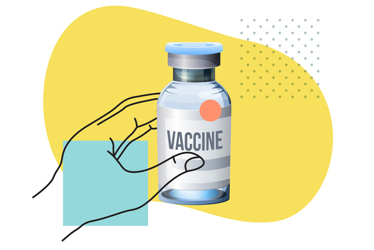Reshaping The Vaccine Manufacturing Paradigm

By Matthew Pillar, Editor, Bioprocess Online

Uvax Bio’s unconventional approach brings a heretofore ignored physical component to vaccine design. Co-founders Dr. Ji Li and Jiang Zhu share why they think their platform is poised to revolutionize vaccine development, manufacturing, and distribution.
Launching a biotech wasn’t Dr. Ji Li’s intention. After earning his Ph.D. in organic chemistry from Princeton, his career spanned roles in R&D and executive management with global industrial chemical and pharmaceutical companies. Those posts took him around the globe, from New Jersey to France to Singapore and Shanghai. When his daughters enrolled in U.S. colleges he moved back to the States, where he set up a small investment firm. It was working in that capacity that led to a meeting with Jiang Zhu, Ph.D., associate professor at the revered Scripps Research Institute and former staff scientist at the NIH Vaccine Research Center (VRC).
What was intended to be a briefing on Dr. Zhu’s novel design of an HIV vaccine turned into a three-hour meeting where the seeds of a company began to germinate. Four months later, in February 2018, Uvax Bio emerged with Dr. Li at the helm as president, CEO, and cofounder, and Dr. Zhu as the cofounder, filling the interim CSO role.

A Biophysical Approach To Vaccine Development

The Uvax strategy features two overarching components, beginning with the optimization of the viral antigen to improve immune response. “A lot of the really bad viruses like HIV, SARS-CoV-2, pandemic flu, RSV, and Ebola belong to the same class known as Class 1 viruses, and they all infect cells using a very similar mechanism,” explains Dr. Zhu. “One of the most critical features of that mechanism is that before the infection occurs, the antigens have to be in an unstable state. Once the antigen touches the cell surface receptor, the interaction triggers an immediate change to that viral protein, merging the cell and viral membranes to let the virus enter.” That, he says, poses a big challenge for vaccines. Taking the native antigens from a virus, or antigens with suboptimal designs, and putting them in any vaccine platform, he explains, naturally results in some degree of instability. “With traditional vaccine platforms, we’re asking the immune system to generate antibodies against an unstable viral protein or a version of it that has changed its appearance. An important differentiator in our strategy is that we seek to rationally optimize the antigen to stabilize it in a stage that represents its appearance before the infection occurs,” says Dr. Zhu.
The second component of the Uvax strategy is what Dr. Zhu describes as the most appealing part, the protein engineering involved in delivering the optimized antigen. “We’ve essentially taken a large, naturally existing protein ball from a remote bacterial strain and re-engineered it to display exactly 20 of these stable antigens on the surface, mimicking what a real virus looks like. We’ve developed a generic platform on which these protein balls can be manufactured to display a variety of antigens to engage multiple viruses.” explains Dr. Zhu. To date, in fact, Uvax is addressing several viruses in its pre-clinical work on the 1c-SApNP platform, including COVID-19, SARS, MERS, RSV, HIV and others. Currently at the IND-enabling stage with the support of a global team of vaccine expert advisors, the company’s COVID-19 effort is its most advanced program, with clinical trials slated for Q3 2021. Its HIV, RSV, and Hepatitis C programs are fast on the COVID candidate’s heels, with clinical trials planned for 2022-2023.
A common theory in the Uvax approach to all these vaccines is that size matters. “When presented with a single entity or a small molecule, our immune system does nothing because it doesn't pose as a threat to us. When our immune system sees a protein in a certain size range, a response is immediately triggered that antibodies must be delivered to the perceived virus,” explains Dr. Zhu. In the Uvax platform, a single DNA construct encodes the entire optimized antigen and nanoparticle subunit; the fully assembled nanoparticle sized at 40-60 nm (depending on the viral protein) displays twenty optimized spike antigens with geometrical precision. Dr. Zhu says that size is optimized for efficient recognition and strong immune response.
“Our immune system learns through evolution to recognize certain patterns in the size, shape, and display of viruses,” he explains. “Many of the current vaccine efforts don’t have those features, because bioengineering the shape of virus-like particles is rather challenging. It takes a combination of virology, structural biology, in silico design, and engineering to manipulate molecules this way.”
Dr. Zhu also asserts that the platform Uvax has developed will produce more universally efficacious vaccine products, citing COVID-19 as an example. “When faced with new strains of COVID-19, the current vaccine products on the market show significant reductions in efficacy,” he says. “Our preclinical studies show that our COVID-19 candidate demonstrates the same results against the original strain and several currently known variants of concern (VOCs).” Quite similar results have also been obtained for efficacy against SARS-CoV-1, the original SARS coronavirus, which caused deadly outbreaks nearly two decades ago.
Addressing Scalability, Regulatory Challenges
Dr. Zhu says that production, on the other hand, is quite simple, at least at the bench scale. Uvax is using an industry-standard CHO cell line to produce its nanoparticle vaccines in a two-week process. “The upfront design work is extensive, but the manufacturing process is relatively simple, quite straightforward, and reusable across all vaccines using our platform,” he says. GMP-manufacture of its COVID-19 vaccine candidate is currently under development. “Our current estimate is that a typical 2,000-liter bioreactor will produce 40 to 50 million doses of our COVID-19 vaccine,” adds Dr. Li. “At the industrial level, we’re confident we can smoothly produce our vaccine molecules at high yield and purity using a one-step expression process and multi-stage chromatographic purification.” In addition, Uvax vaccines are protein-, not lipid-based, so a deep cold chain is unnecessary. Global distribution and storage, including to remote geographies, is therefore more feasible and cost-effective.
The Uvax approach stands on the shoulders of one of the most efficacious vaccines ever developed, the HPV vaccine, Gardasil. “Our design was inspired, in part, by the HPV vaccine, which is a vaccine that elicits 100% protection for life, and is perhaps the most successful vaccine in history,” says Dr. Zhu. That vaccine is a “protein ball” as well, developed on the basis of the protein shell of the actual virus, human papillomavirus (HPV). Despite the differences, Drs. Li and Zhu are confident that the precedent set by the mechanistic action of the HPV vaccine will ease the company’s regulatory pathway.
“The design we’ve developed is simple and elegant, and that’s the way it should be,” concludes Dr Zhu.
Learn more about Uvax Bio and its vaccine development platform here.

